An attempt to localize ChatGPT technology

The topic of this sharing is ChatGPT technology, localization attempts and open source models. The sharing consists of three parts. The first part gives an overall introduction to ChatGPT related technologies: the evolution of ChatGPT technology, current problems, the three stages of ChatGPT technology learning, data organization and effect evaluation; the second part shares our experience in ChatGPT Our attempts at technology localization include the problems we encountered during the experiment, our thoughts, and the effects and applications of the model; the third part introduces the Chinese open source large model we have released, and how to use our own data to train a local model During the operation, the problems that may be encountered during the experiment, the gaps between it and the open source advanced model, and how to further improve the effect of the model.
1. ChatGPT related technologies
ChatGPT is a general functional assistant. On December 5, 2022, OpenAI CEO Sam Altman posted on social media that ChatGPT had exceeded 1 million users five days after its launch. The AI chatbot ChatGPT exploded into popularity and has become a landmark event. Microsoft is in talks to increase its stake by $10 billion and soon integrate it into the Microsoft Cloud.
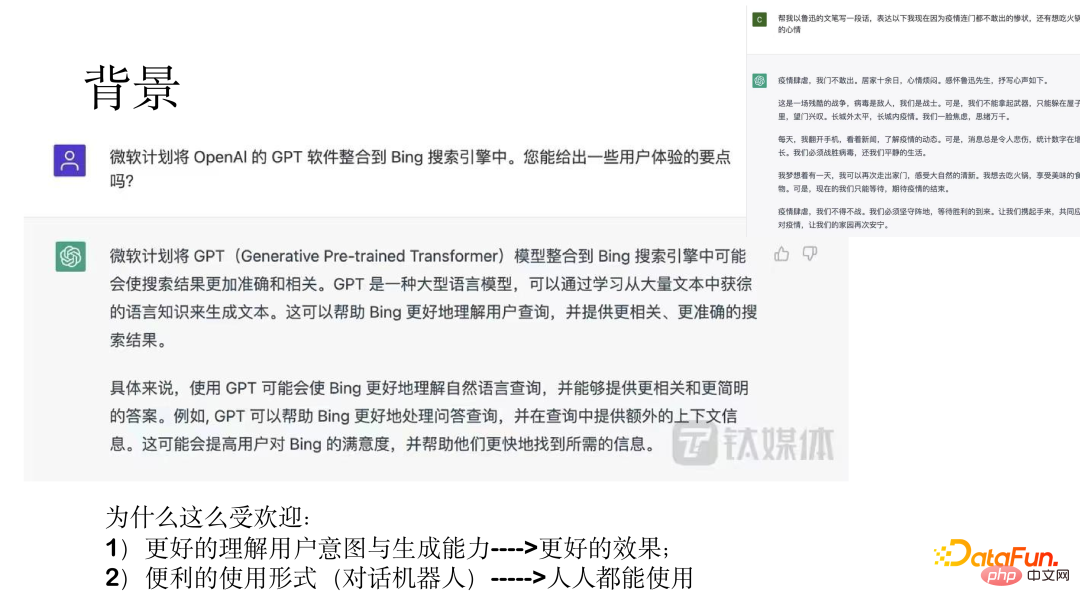
The above picture shows two examples, showing amazing results.
The reason why ChatGPT is so popular is, on the one hand, its ability to understand user intentions and its better generated effects; on the other hand, through the use of conversational robots form so that everyone can use it.
The following will cover the evolution of the model, problems with the initial model, the three stages of ChatGPT model learning, and the data organization and effects of training the ChatGPT model. introduce.
1. Model evolution
ChatGPT technology has also evolved through several generations of models. The initial GPT model is Proposed in 2018, the model parameters were only 117 million; in 2019, the GPT-2 model parameters were 1.5 billion; by 2020, the GPT-3 model parameters reached 175 billion; through several generations of model update iterations, it will appear by 2022 ChatGPT model.
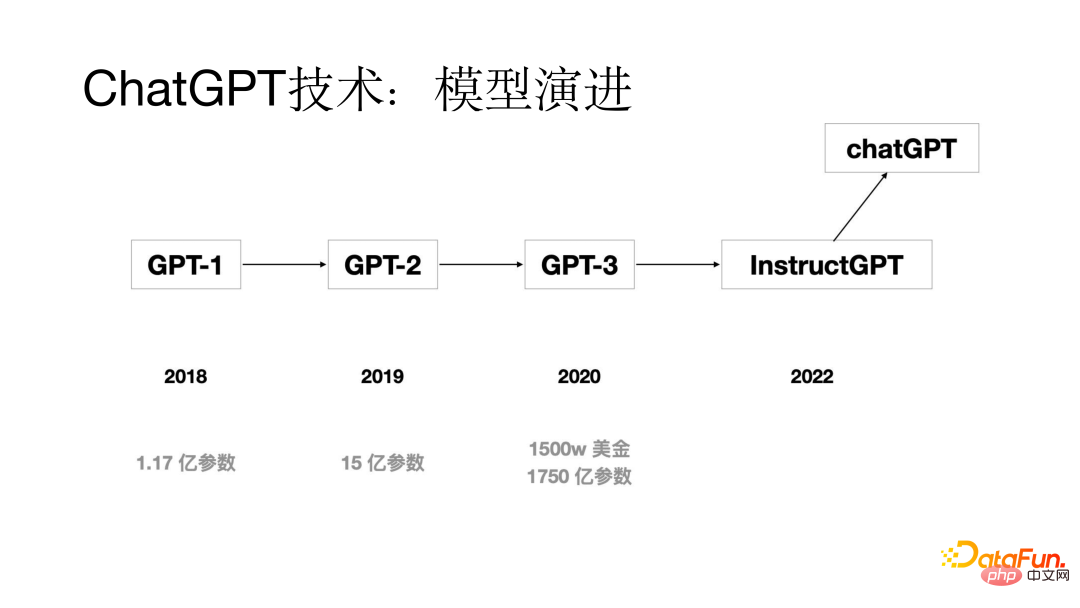
2. What kind of problems did the previous model have?
In What were the problems with the models before the ChatGPT model came out? Through analysis, it was found that one of the more obvious problems is the alignment problem. Although the generation ability of large models is relatively strong, the generated answers sometimes do not meet the user's intention. Through research, it was found that the main reason for the alignment problem is that the training goal of language model training is to predict the next word, rather than generate it according to the user's intention. In order to solve the alignment problem, the Reinforcement Learning from Human Feedback (RLHF) process is added to the training process of the ChatGPT model.
3. Three stages of learning
The training process of the ChatGPT model is carried out in a three-step process.
The first step is to use real user input for supervised learning based on the GPT model. In this The data in the process comes from real users, and the data quality is relatively high and valuable.
The second step is to train a reward model. Different models will produce different outputs for a query. As a result, the tagger sorts the output results of all models and uses these sorted data to train the reward model.
The third step is to Input the preliminary answer generated by the model into the reward model. The reward model will evaluate the answer. If the generated If the answer meets the user's intention, a positive feedback will be given, otherwise a negative feedback will be given, thereby making the model better and better. This is the purpose of introducing reinforcement learning to make the generated results more in line with human needs. The three-step process of training the ChatGPT model is shown in the figure below.

4. Data organization and effect evaluation
Before training the model, we need to prepare the data set to be used. In this process, we will encounter the problem of data cold start, can be solved through the following three aspects:
(1) Collect data sets used by users of the old system
(2) Let the annotators annotate some similar prompts and output
based on the questions input by real users before Think of some prompts.
The data for training the ChatGPT model contains three parts of the data set (77k real data):
(1) Supervised learning based on real user prompts Data, user prompt, model response, the amount of data is 13k.
(2) The data set used to train the reward model. This part of the data is for the sorting of multiple responses corresponding to one prompt, and the data volume is 33k.
# (3) A data set based on the reward model using reinforcement learning technology for model training. It only requires user prompts. The data volume is 31k and has high quality requirements. .
After completing the ChatGPT model training, the evaluation of the model is relatively sufficient, mainly from the following aspects:
(1 ) Whether the results generated by the model meet the user's intention
(2) Whether the generated results can satisfy the constraints mentioned by the user
(3) Whether the model can have good results in the field of customer service
Details of comparison with the GPT basic model The experimental results are shown in the figure below.
2. Localization of ChatGPT technology
The following will discuss the background and problems, solution ideas, effects and practices. This aspect introduces our localization of ChatGPT technology.
1. Background and issues
Why we need to carry out localization, we mainly consider the following aspects:
(1) ChatGPT technology itself is relatively advanced and works well on many tasks, but it does not provide services to mainland China.
# (2) It may not be able to meet the needs of domestic enterprise-level customers and cannot provide localized technical support and services.
# (3) The price is priced in US dollars in Europe and the United States as the main markets. The price is relatively expensive and most domestic users may not be able to afford it. Through testing, it was found that each piece of data costs about 0.5 yuan, and commercialization is impossible for customers with large amounts of data.
Due to the above three problems, we tried to localize ChatGPT technology.
2. Solution ideas
#We are in the process of localizing ChatGPT technology, A distributed strategy was adopted.
First, a Chinese pre-training model with tens of billions of parameters was trained; secondly, task supervised learning was performed using Prompt on billion-level task data; and then the model was conversationalized, that is, in Interact with people in the form of dialogue or human-computer interaction; finally, we introduce the reinforcement learning RLHF technology of reward model and user feedback.
Prompt multi-task learning model (PromptCLUE) is a model that supports zero-sample learning for all Chinese tasks. This model achieves three major unifications: unified model, unified data form (all tasks are converted into prompt form), and unified usage method (used in zero-sample form). The model is based on unsupervised learning of 100 billion Chinese word-level tokens. It is trained on billion-level downstream task data and has accumulated 1.5 trillion Chinese word-level tokens. Supports zero-sample use on more than 20 tasks (text understanding, extraction, and generation tasks).
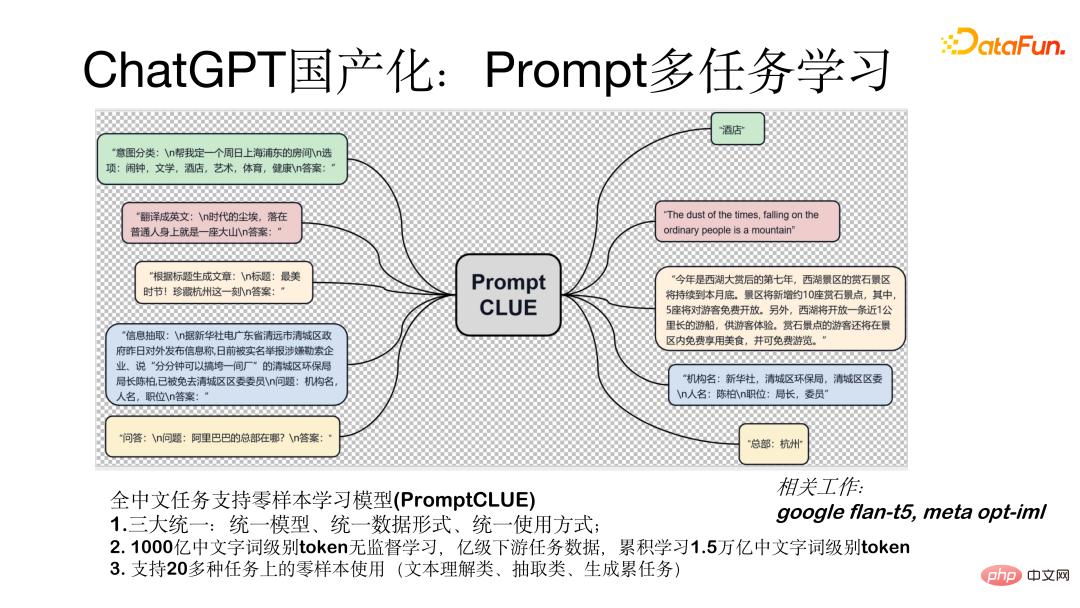
How to make the model conversational, that is, convert it into a model in the form of human-computer interaction, we mainly did the following aspects Work:
First of all, in order to make the model have a better generation effect, we removed the text understanding and extraction tasks, thus strengthening the question and answer, dialogue and generation tasks. learning; secondly, after transforming into a dialogue model, the generated results will be interfered by the context. To address this problem, we added anti-interference data so that the model can ignore irrelevant context when necessary; finally, we based on the feedback data of real users A learning process is added to enable the model to better understand the user's intentions. The figure below shows the form of single-round and multi-round testing with the model.

3. Effect and practice
The following is a test for the model By comparing the current effect with the ChatGPT model, there is still a gap of 1 to 2 years. However, this gap can be gradually made up. At present, we have made some useful attempts and have achieved certain results. We can currently have some dialogues. , Q&A, writing and other interactions. The image below shows the test results.
##3. Domestic open source large model
1. Chinese open source model
The metalanguage functional dialogue model (ChatYuan) we just released recently has 770 million parameters. The online version is a model with 10 billion parameters. It has been launched on multiple platforms, including Huggingface, ModelScope, and Github. , paddlepaddle can be used. Models can be downloaded locally and fine-tuned based on your own user data set. It is further trained based on PromptCLUE-large combined with hundreds of millions of functional dialogue multi-round dialogue data.
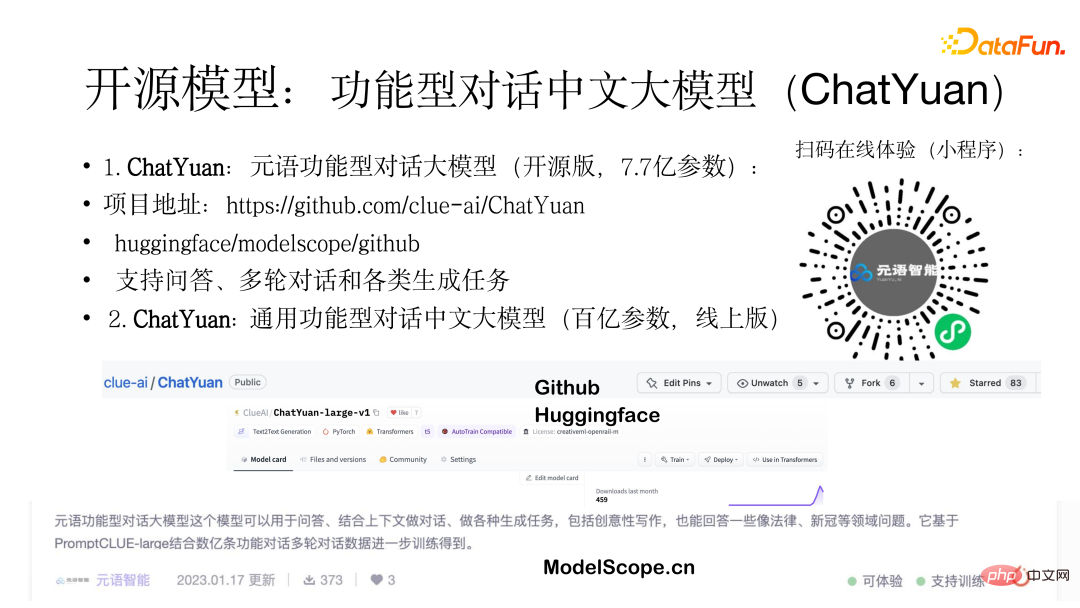
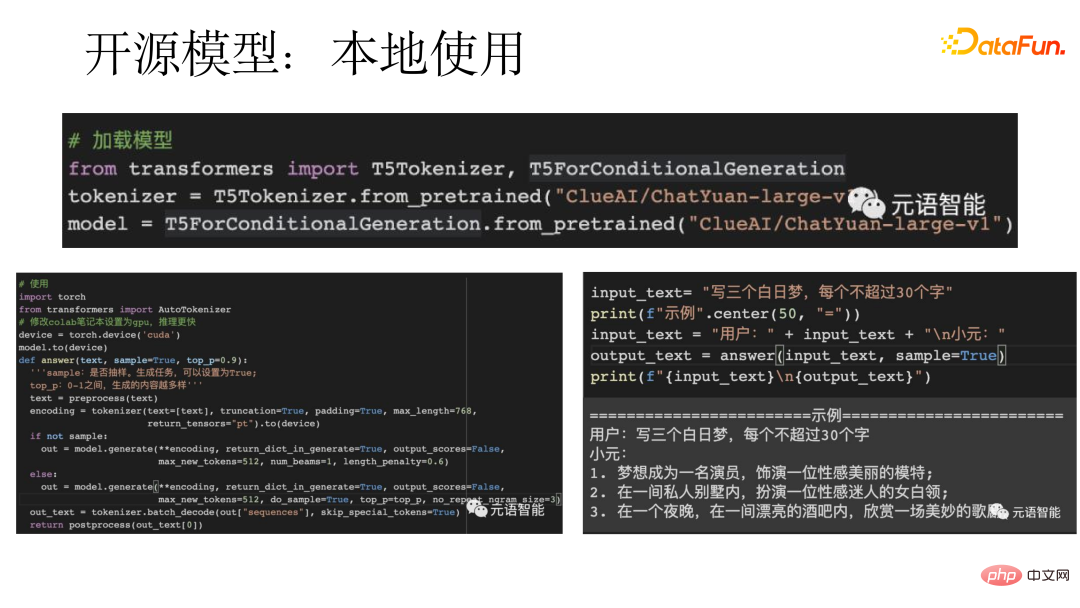
## The Huggingface platform is taken as an example to show how to use the model locally. Search ChatYuan on the platform, load the model, and perform simple packaging. There are some important parameters in use, such as whether to sample samples. If you need to generate a variety of samples, you need to sample. #First, the data needs to be organized into a unified form, which consists of two parts: input and Output. For a single round of question and answer or generated input (Input): task description input text (such as: "User: Hello n Xiaoyuan:"), output (Output) refers to the text that the system needs to predict (such as: "Hello! I am Metalanguage AI..."). For multi-round dialogue input (Input): Task description above input text, output refers to the text that the system needs to predict, as shown in the figure below after "Xiaoyuan". The following figure shows an example of training a local model based on your own data. This example covers the entire process, from data preparation to downloading and converting open source data, as well as model training, prediction, and evaluation. The basis is the pCLUE multi-task dataset. Users can use their own data for training, or use pCLUE for preliminary training to test the effect. ChatYuan and ChatGPT are both general functional conversation models, capable of question and answer, interaction and generation in chatting or professional fields such as law and medicine. Compared with the ChatGPT model, there is still a certain gap, mainly reflected in the following aspects: In the process of using the model, you may encounter problems with the generation effect and text length, depending on whether the data format is correct and whether during the generation process Sampling sample, the length of the output result controls max_length, etc. To further improve the model effect, you can start from the following aspects: (1) Combine industry data for further training, including unsupervised pre-training, and use a large amount of high-quality data for supervised learning. ## (2) Learning using real user feedback data can compensate for distribution differences. #(3) Introduce reinforcement learning to align user intentions. # (4) Choose a larger model. Generally speaking, the larger the model, the stronger the model capability. The new technologies and usage scenarios brought by ChatGPT allow people to see the huge potential of AI. More applications will be upgraded, creating possibilities for some new applications. Yuanyu Intelligence, as a large model Model-as-a-Service service provider, is also constantly exploring in this field. Interested partners are welcome to pay attention to our website and official account. That’s it for today’s sharing, thank you all. 2. Training local models based on own data
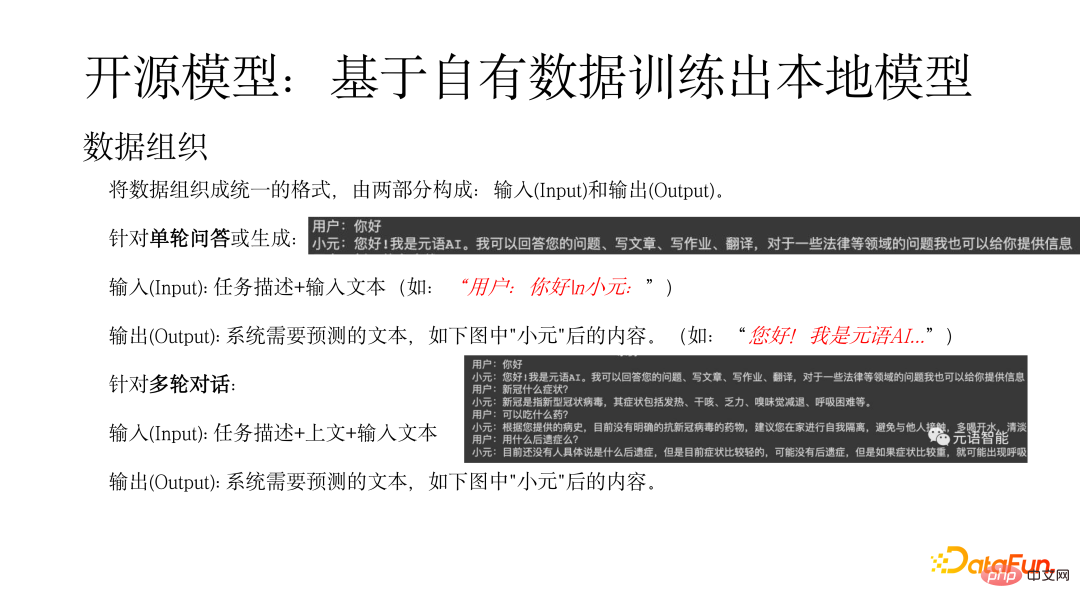
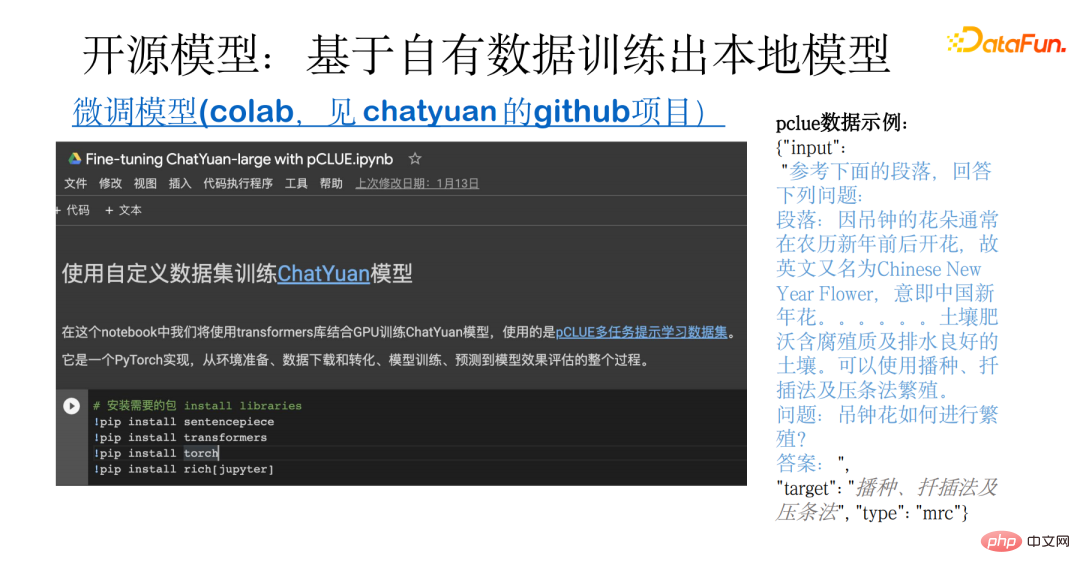
3. Possible problems, gaps and how to further improve the effect
The above is the detailed content of An attempt to localize ChatGPT technology. For more information, please follow other related articles on the PHP Chinese website!

Hot AI Tools

Undresser.AI Undress
AI-powered app for creating realistic nude photos

AI Clothes Remover
Online AI tool for removing clothes from photos.

Undress AI Tool
Undress images for free

Clothoff.io
AI clothes remover

Video Face Swap
Swap faces in any video effortlessly with our completely free AI face swap tool!

Hot Article

Hot Tools

Notepad++7.3.1
Easy-to-use and free code editor

SublimeText3 Chinese version
Chinese version, very easy to use

Zend Studio 13.0.1
Powerful PHP integrated development environment

Dreamweaver CS6
Visual web development tools

SublimeText3 Mac version
God-level code editing software (SublimeText3)

Hot Topics
 ChatGPT now allows free users to generate images by using DALL-E 3 with a daily limit
Aug 09, 2024 pm 09:37 PM
ChatGPT now allows free users to generate images by using DALL-E 3 with a daily limit
Aug 09, 2024 pm 09:37 PM
DALL-E 3 was officially introduced in September of 2023 as a vastly improved model than its predecessor. It is considered one of the best AI image generators to date, capable of creating images with intricate detail. However, at launch, it was exclus
 A new programming paradigm, when Spring Boot meets OpenAI
Feb 01, 2024 pm 09:18 PM
A new programming paradigm, when Spring Boot meets OpenAI
Feb 01, 2024 pm 09:18 PM
In 2023, AI technology has become a hot topic and has a huge impact on various industries, especially in the programming field. People are increasingly aware of the importance of AI technology, and the Spring community is no exception. With the continuous advancement of GenAI (General Artificial Intelligence) technology, it has become crucial and urgent to simplify the creation of applications with AI functions. Against this background, "SpringAI" emerged, aiming to simplify the process of developing AI functional applications, making it simple and intuitive and avoiding unnecessary complexity. Through "SpringAI", developers can more easily build applications with AI functions, making them easier to use and operate.
 Choosing the embedding model that best fits your data: A comparison test of OpenAI and open source multi-language embeddings
Feb 26, 2024 pm 06:10 PM
Choosing the embedding model that best fits your data: A comparison test of OpenAI and open source multi-language embeddings
Feb 26, 2024 pm 06:10 PM
OpenAI recently announced the launch of their latest generation embedding model embeddingv3, which they claim is the most performant embedding model with higher multi-language performance. This batch of models is divided into two types: the smaller text-embeddings-3-small and the more powerful and larger text-embeddings-3-large. Little information is disclosed about how these models are designed and trained, and the models are only accessible through paid APIs. So there have been many open source embedding models. But how do these open source models compare with the OpenAI closed source model? This article will empirically compare the performance of these new models with open source models. We plan to create a data
 How to install chatgpt on mobile phone
Mar 05, 2024 pm 02:31 PM
How to install chatgpt on mobile phone
Mar 05, 2024 pm 02:31 PM
Installation steps: 1. Download the ChatGTP software from the ChatGTP official website or mobile store; 2. After opening it, in the settings interface, select the language as Chinese; 3. In the game interface, select human-machine game and set the Chinese spectrum; 4 . After starting, enter commands in the chat window to interact with the software.
 Posthumous work of the OpenAI Super Alignment Team: Two large models play a game, and the output becomes more understandable
Jul 19, 2024 am 01:29 AM
Posthumous work of the OpenAI Super Alignment Team: Two large models play a game, and the output becomes more understandable
Jul 19, 2024 am 01:29 AM
If the answer given by the AI model is incomprehensible at all, would you dare to use it? As machine learning systems are used in more important areas, it becomes increasingly important to demonstrate why we can trust their output, and when not to trust them. One possible way to gain trust in the output of a complex system is to require the system to produce an interpretation of its output that is readable to a human or another trusted system, that is, fully understandable to the point that any possible errors can be found. For example, to build trust in the judicial system, we require courts to provide clear and readable written opinions that explain and support their decisions. For large language models, we can also adopt a similar approach. However, when taking this approach, ensure that the language model generates
 Rust-based Zed editor has been open sourced, with built-in support for OpenAI and GitHub Copilot
Feb 01, 2024 pm 02:51 PM
Rust-based Zed editor has been open sourced, with built-in support for OpenAI and GitHub Copilot
Feb 01, 2024 pm 02:51 PM
Author丨Compiled by TimAnderson丨Produced by Noah|51CTO Technology Stack (WeChat ID: blog51cto) The Zed editor project is still in the pre-release stage and has been open sourced under AGPL, GPL and Apache licenses. The editor features high performance and multiple AI-assisted options, but is currently only available on the Mac platform. Nathan Sobo explained in a post that in the Zed project's code base on GitHub, the editor part is licensed under the GPL, the server-side components are licensed under the AGPL, and the GPUI (GPU Accelerated User) The interface) part adopts the Apache2.0 license. GPUI is a product developed by the Zed team
 The local running performance of the Embedding service exceeds that of OpenAI Text-Embedding-Ada-002, which is so convenient!
Apr 15, 2024 am 09:01 AM
The local running performance of the Embedding service exceeds that of OpenAI Text-Embedding-Ada-002, which is so convenient!
Apr 15, 2024 am 09:01 AM
Ollama is a super practical tool that allows you to easily run open source models such as Llama2, Mistral, and Gemma locally. In this article, I will introduce how to use Ollama to vectorize text. If you have not installed Ollama locally, you can read this article. In this article we will use the nomic-embed-text[2] model. It is a text encoder that outperforms OpenAI text-embedding-ada-002 and text-embedding-3-small on short context and long context tasks. Start the nomic-embed-text service when you have successfully installed o
 Don't wait for OpenAI, wait for Open-Sora to be fully open source
Mar 18, 2024 pm 08:40 PM
Don't wait for OpenAI, wait for Open-Sora to be fully open source
Mar 18, 2024 pm 08:40 PM
Not long ago, OpenAISora quickly became popular with its amazing video generation effects. It stood out among the crowd of literary video models and became the focus of global attention. Following the launch of the Sora training inference reproduction process with a 46% cost reduction 2 weeks ago, the Colossal-AI team has fully open sourced the world's first Sora-like architecture video generation model "Open-Sora1.0", covering the entire training process, including data processing, all training details and model weights, and join hands with global AI enthusiasts to promote a new era of video creation. For a sneak peek, let’s take a look at a video of a bustling city generated by the “Open-Sora1.0” model released by the Colossal-AI team. Open-Sora1.0






